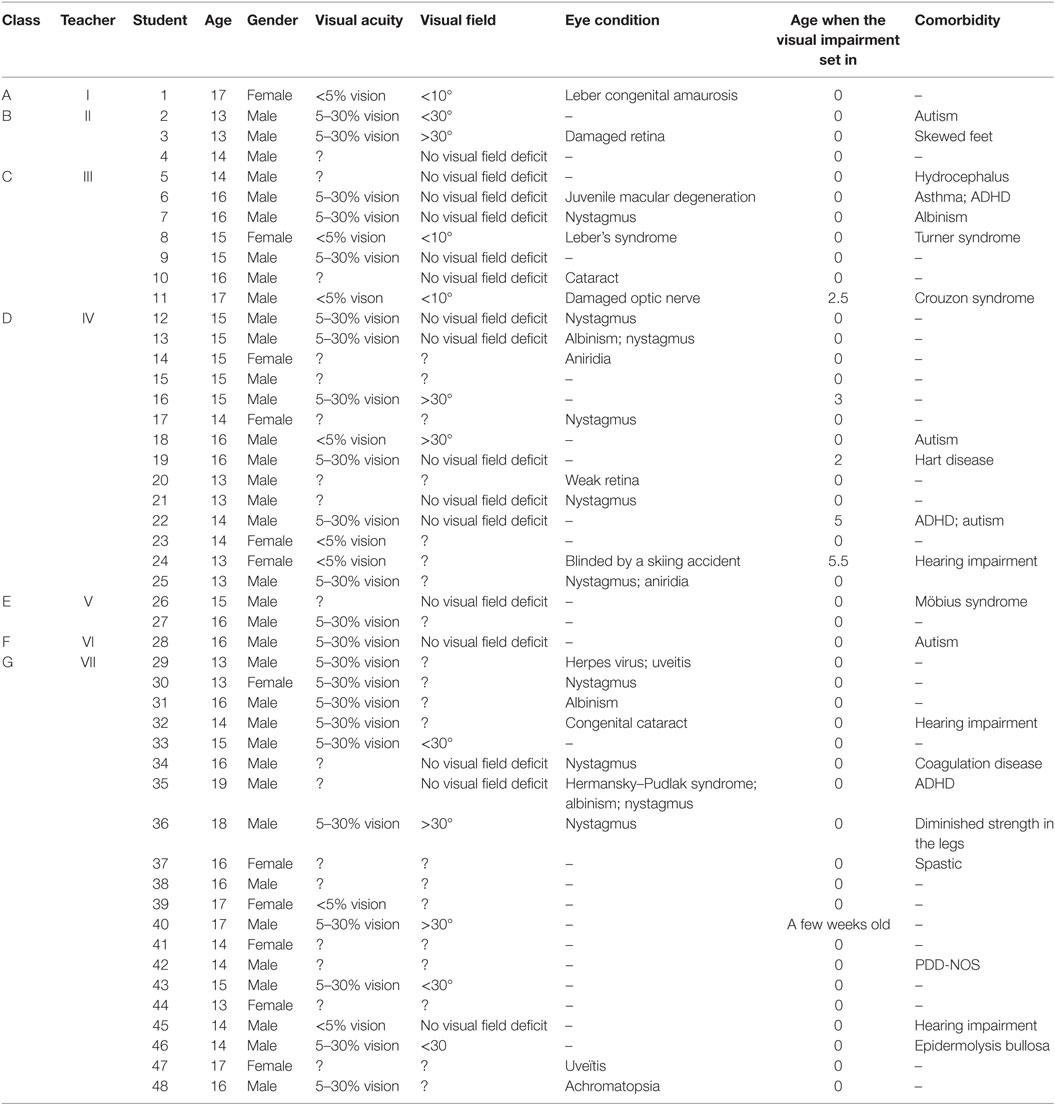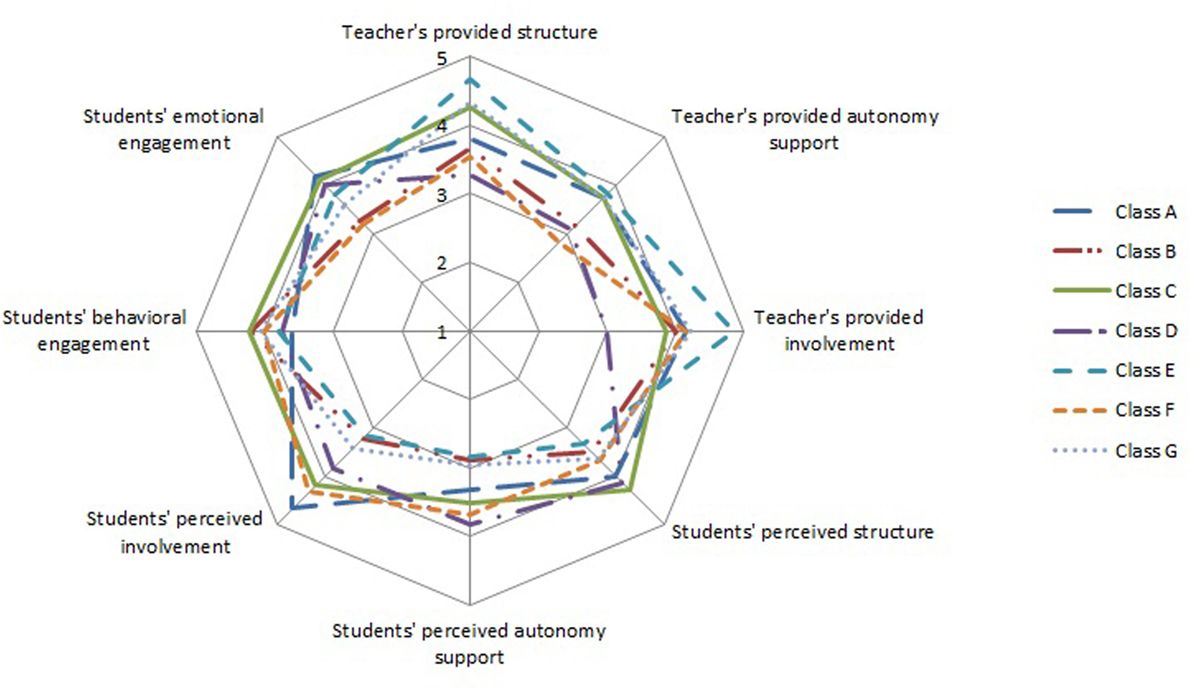- Department of Special Needs Education and Youth Care, University of Groningen, Groningen, Netherlands
According to self-determination theory (SDT), need-supportive teaching positively influences students’ engagement to learn. Need-supportive teaching involves teachers providing students with structure, autonomy support, and involvement. It enables teachers to support students’ psychological needs to feel competent, autonomous, and related. Supporting students’ needs consequently has a positive influence on students’ engagement to learn. Little is known about need-supportive teaching in the education of students with visual impairments. In this study, we used a questionnaire to assess the self-reported provision of need support by teachers of students with visual impairments, the students’ perceived need support, and the students’ behavioral and emotional engagement. Seven teachers and 48 students filled in questionnaires based on SDT. In general, mean scores were positive. The teachers’ mean scores for the need support they provided, the students’ mean scores for their perceived need support, and the students’ mean scores for engagement all ranged between 3 and 4 on a 5-point scale. The teachers and students scored highest on involvement, followed by structure, and then autonomy support. When looking at scores on an individual student level, we found large differences between students in the same class, which implies that need support requires an individualized approach. Hence, teachers need to be aware of their students’ individual needs for structure, autonomy support, and involvement and should adjust their need-supportive teaching accordingly, thereby enabling teachers to have a positive impact on the engagement of students with visual impairments.
Introduction
Supporting students’ psychological needs for competence, autonomy, and relatedness has a positive influence on students’ motivation to engage in learning tasks (Deci and Ryan, 2000). Teachers can support the basic psychological needs of students by providing them with structure, autonomy support, and involvement. Providing support for students’ basic psychological needs is also known as need-supportive teaching. The extent to which students experience their teachers as supporting their needs has a crucial influence on their engagement in the classroom (Appleton et al., 2008).
In this study, we explore need-supportive teaching in a specific group of students: students with visual impairments, meaning students who are blind or have low vision (Chang and Schaller, 2002). Visual impairments can seriously hinder a student’s motivation to engage in learning tasks, which is caused for instance by a limited ability to learn by imitation and observation, and by difficulties in giving meaning to objects, concepts, and ideas (Sacks and Silberman, 1998; Pinquart and Pfeiffer, 2012). Teachers of students with visual impairments have a very important role in helping students to overcome the barriers posed by their visual impairments. Moreover, teachers are responsible for creating safe and accessible learning environments that trigger students’ motivation to engage in learning tasks. Yet, there is limited literature on how teachers motivate students with these special educational needs.
As such, we aim to explore the extent to which teachers of students with visual impairments indicate they support their students’ needs. Second, we aim to explore students’ view on the need support provided by their teachers, which will allow us to compare teachers’ self-reported provision of need support with students’ perceived need support. Last, we investigate the influence of teachers’ self-reported provision of need support and students’ perceived need support on student engagement.
The notion of the three basic psychological needs and their influence on peoples’ motivation is derived from self-determination theory (SDT, Deci and Ryan, 2000). According to SDT, the need to feel competent reflects students’ need to believe in themselves. Competence is the belief that they have the knowledge and skills to succeed in learning tasks. Autonomy relates to people experiencing a sense of space for their own initiatives. It is the ability to make their own choices in line with their own beliefs, values, and preferences. Relatedness reflects the desire to be connected to others and to experience safety, care, and contact (Vansteenkiste, 2010).
Research shows that if these three needs are fostered in interactions with their teachers, students will be more engaged in learning (see Figure 1). As we know, teachers can support the basic psychological needs of students by providing structure, autonomy support, and involvement. Structure can be provided by offering clear guidelines, expressing clear expectations, and offering constructive feedback. Structure helps students feel competent (Jang et al., 2010; Vansteenkiste, 2010). Knowing what is expected and knowing how to achieve desired outcomes makes students feel capable of succeeding in learning tasks.
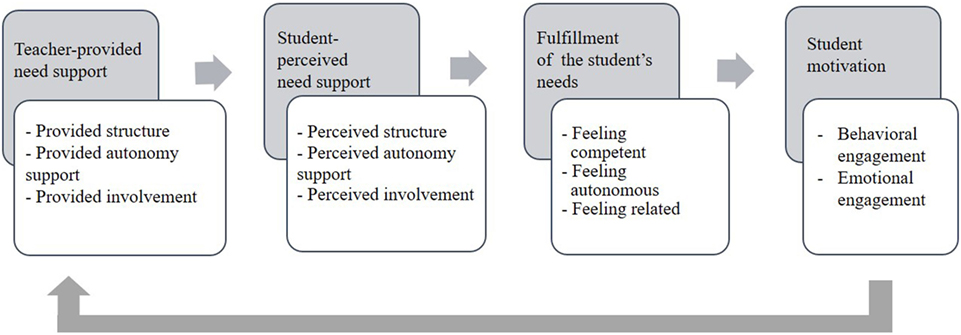
Figure 1. Theoretical model. Note: adapted from (Appleton et al., 2008).
Teachers can support students’ autonomy by providing opportunities for self-initiative. Students need to feel a learning task is self-chosen and based on their own needs and values (Stroet et al., 2013). Autonomy support includes making students willing to learn without forcing them.
Teachers can fosters students’ perceived relatedness by showing involvement. People are born with an intrinsic need to be connected to others and to experience warmth and care (Bowlby, 1979). In the classroom, involvement is visible in teachers who are interested in their students (Vansteenkiste, 2010). Teachers can show involvement by being responsive and creating a warm and safe classroom environment.
In sum, supporting students’ needs for competence, autonomy, and relatedness by providing structure, autonomy support, and involvement positively influences students’ motivation to engage in learning tasks. Different types of engagement in learning are distinguished in the literature, such as behavioral and emotional engagement (Fredricks et al., 2004). Behavioral engagement relates to students’ performance during learning tasks and includes behaviors, such as effort, attention, and persistence. Emotional engagement refers to a student’s state of mind during a learning task, for example, their enthusiasm, interest, and enjoyment. Students are more inclined to show behavioral and emotional engagement when they feel supported in their basic psychological needs.
Self-determination theory has been applied in a wide range of settings, including the educational setting. However, research on students with special educational needs is scarce. A literature study on students with visual impairments, hearing impairments, and deafblindness showed that the theoretical framework of SDT as a whole has never been applied in the education of students with sensory loss (see Haakma et al., 2016a). To fill this research gap, we started studying the application of SDT in the education of students with deafblindness. In our studies, we analyzed many hours of videos of interactions between teachers and students, using an observation scheme based on SDT. The recordings included various teacher–student pairs involved in a broad range of learning tasks in different educational settings. These studies provided insights into how need-supportive teaching influences the motivation of students with either congenital (Haakma et al., 2017a) or acquired (Haakma et al., 2016b) deafblindness to engage in learning. More insight into how this works for students with visual impairments is needed to further our understanding and improve our support.
We do know from literature that students with visual impairments often struggle with personal competence, motivation, and self-determination (Bardin and Lewis, 2011). According to Bardin and Lewis (2011), teachers of students with visual impairments should focus on the development of these skills and attitudes to improve students’ academic engagement, since these areas have been identified as positively influencing engagement. In the current study, we hope to shed more light on these issues to gain a better understanding of the factors that influence the learning process of students with visual impairments.
The purpose of the current study is to explore the relationship between need-supportive teaching and the motivation of students with visual impairments in secondary education. In this study, we answer the following questions:
1. To what extent do teachers support the psychological needs of students with visual impairments?
2. To what extent do students with visual impairments perceive their needs as being supported?
3. What is the relationship between teacher-provided and student-perceived need support?
4. What is the relationship between teacher-provided and student-perceived need support and student engagement in learning?
Materials and Methods
In this study, we focus on mother tongue language learning in secondary education. We chose this subject because it is a universal key domain in educational curricula. As part of our study, questionnaires were administered among secondary school students with visual impairments and their teachers. Secondary schools were chosen since students at this age are capable of filling out a questionnaire independently.
Participants
In the Netherlands, two main organizations facilitate education for students with visual impairments, which includes both special education schools and support services for students in mainstream schools. We contacted these organizations so we could approach teachers and students in both special and mainstream settings for participation in this study. The criteria for inclusion were: (1) teachers had to teach the mother tongue language and (2) students had to be able to fill out a questionnaire independently. All teachers, students, and parents received an information letter that explained the study purpose and content. A total of 7 teachers and 48 students completed the questionnaire. Tables 1 and 2 provide an overview of the teachers’ and students’ characteristics.
Student Questionnaire
All students completed the student questionnaire. The first section of the questionnaire contained the informed consent form. In the form, it was stated that participation in the study was voluntary along with other information. The Ethics Committee Pedagogical and Educational Sciences checked our research and concluded that we have met the criteria of scientifically responsible behavior. The second part of the questionnaire included questions regarding the student’s background. We asked for information such as the student’s age and degree of vision loss. The third and main part of the questionnaire was divided into two sections. Part A listed statements about the extent to which students perceived their teachers as need supportive: that is, the degree to which teachers provide structure, autonomy support, and involvement. Part B listed statements on student engagement. In both parts A and B, all answers were given on a 5-point Likert scale, ranging from 1 (completely false) to 5 (completely true).
The questionnaire was based on a questionnaire constructed by Opdenakker (2014), a Flemish questionnaire based in turn on the English questionnaire of Wellborn et al. (1991). In our studies, we made some linguistic changes to make the questionnaire suitable for the Dutch population.
We conducted two small pilot studies to review the questionnaire. In the first pilot study, six sighted secondary school students completed the questionnaire. Based on their experiences with the questionnaire, a few textual changes were made to clarify items that these students found difficult to understand. Before starting the second pilot study, we decided to make the questionnaire available online as well so that students with visual impairments could complete the questionnaire on their own computers using their own software. In the second pilot study, the questionnaire was completed by a blind person and a person with visual loss. The study allowed us to assess whether students with visual impairments experienced difficulties with filling in the questionnaire. The two participants found the first and second parts of the questionnaire easy, but had difficulty with the 5-point scale answers in the third part. Therefore, we changed the layout of the questionnaire, replacing the horizontal 5-point scale by a multiple-choice answer format with each of the five answer options presented underneath each other.
Teacher Questionnaire
All teachers completed the teacher questionnaire. The teacher questionnaire was structured in a similar way to the student questionnaire, beginning with the informed consent form and the background information questions. The third part listed statements on teacher-provided need support, that is, the degree to which they thought/felt they provided structure, autonomy support, and involvement in their classes. Similar to the student questionnaires, answers were given on a 5-point scale. This questionnaire was also based on the Opdenakker (2014) questionnaire and also required some minor textual changes to make it applicable for a Dutch population.
Analyses
We started the data analyses by combining all items on each of the three needs. Next, we calculated the mean sum scores. The same method was then applied to the items on engagement. The scores were presented in a table and a spider chart. We calculated effect sizes to compare the teacher-provided and student-perceived need support. These were simple effect-size calculations, which involved subtracting the mean student scores from the mean teacher score and then dividing this by the SD of the student scores. We also made boxplots to graphically compare the distributions between the classes. To compare teacher and student scores, these boxplots show the range of the student scores and the teachers’ mean score per class. To compare teacher-provided and student-perceived need support with student engagement scores, we also made boxplots of students’ behavioral and emotional engagement scores and added the mean scores for need support.
Results
Research Question 1: To What Extent Do Teachers Support the Psychological Needs of Students with Visual Impairments?
Table 3 provides an overview of the mean sum scores of the teachers and students. Table 3 shows the scores of the teachers for each of the three dimensions of need support (second, third, and fourth column). The mean class scores of the students in each teacher’s class are presented in the fifth, sixth, and seventh column. The last four columns present the mean class scores for students’ behavioral and emotional engagement. The last row shows the grand mean scores across classes.
Table 3 shows that teachers indicated they provide involvement the most (mean 4.03), followed by structure (mean 3.90) and autonomy support (mean 3.45). Involvement scores show the highest variability between the seven teachers (3.00 − 4.85 = 1.85), followed by the scores for structure (3.27 − 4.67 = 1.40) and the scores for autonomy support (2.83 − 3.83 = 1.00).
Research Question 2: To What Extent Do Students with Visual Impairments Perceive Their Needs As Being Supported?
Similar to teacher-provided need support, students’ mean class scores also mainly ranged between 3 and 4 on a 5-point scale (see Table 3). When comparing the scores on the three needs, we found that on a group level students felt their teachers provided involvement the most (mean 3.83), followed by structure (mean 3.80) and autonomy support (mean 3.29).
With regard to students’ variability, we found the highest variability for involvement (3.17 − 4.67 = 1.50), followed by autonomy support (2.84 − 3.83 = 0.99) and structure (3.34 − 4.29 = 0.95).
Surprising results were found in class A: the mainstream class with only one student with a visual impairment. This student gave very high scores for perceived structure (4.00), autonomy support (3.33), and involvement (4.67). We expected much lower scores, given that the teacher in this classroom has to divide his attention over a larger number of students than the teachers in the special education settings.
Research Question 3: What Is the Relationship between Teacher-Provided and Student-Perceived Need Support?
We calculated effect sizes and made boxplots and a spider chart to answer this question. The spider chart (Figure 2) shows the mean sum scores for all teachers and students in one visual overview. Scores in the middle of the web are lowest. The further the scores are from the middle of the web, the higher they are.
The data in Figure 2 clearly shows that teacher and student scores generally seem to be within the same range between 3 and 5. As such, these scores seem very similar at first sight. The data in Table 3 show that teachers are slightly more positive about the need support they provide than their students (3.90 for the teachers’ mean structure, compared to 3.80 for students; 3.45 for the teachers’ mean autonomy support, compared to 3.29 for students; and 4.03 for teachers’ mean involvement, compared to 3.83 for students).
We also calculated effect sizes for the differences between teacher and student scores in classes B, C, D, E, and G. Classes A and F have only one student, so no SD could be calculated. In classes B, E, and G, the teachers were more positive about the need support they provided than their students (see Table 4). In contrast, the students in class D were more positive about their teacher’s need support than the teacher herself was. In class C, students were more positive than their teacher about her structure and involvement and less positive about her autonomy support.

Table 4. Effect sizes of teacher-student differences in structure, autonomy support, and involvement.
The boxplots in Figure 3 show the shape of the distribution of the scores for student-perceived need support. We compared these scores with the teachers’ scores by adding horizontal lines for the teachers’ mean scores. Again, we only made boxplots of classes B, C, D, E, and G.
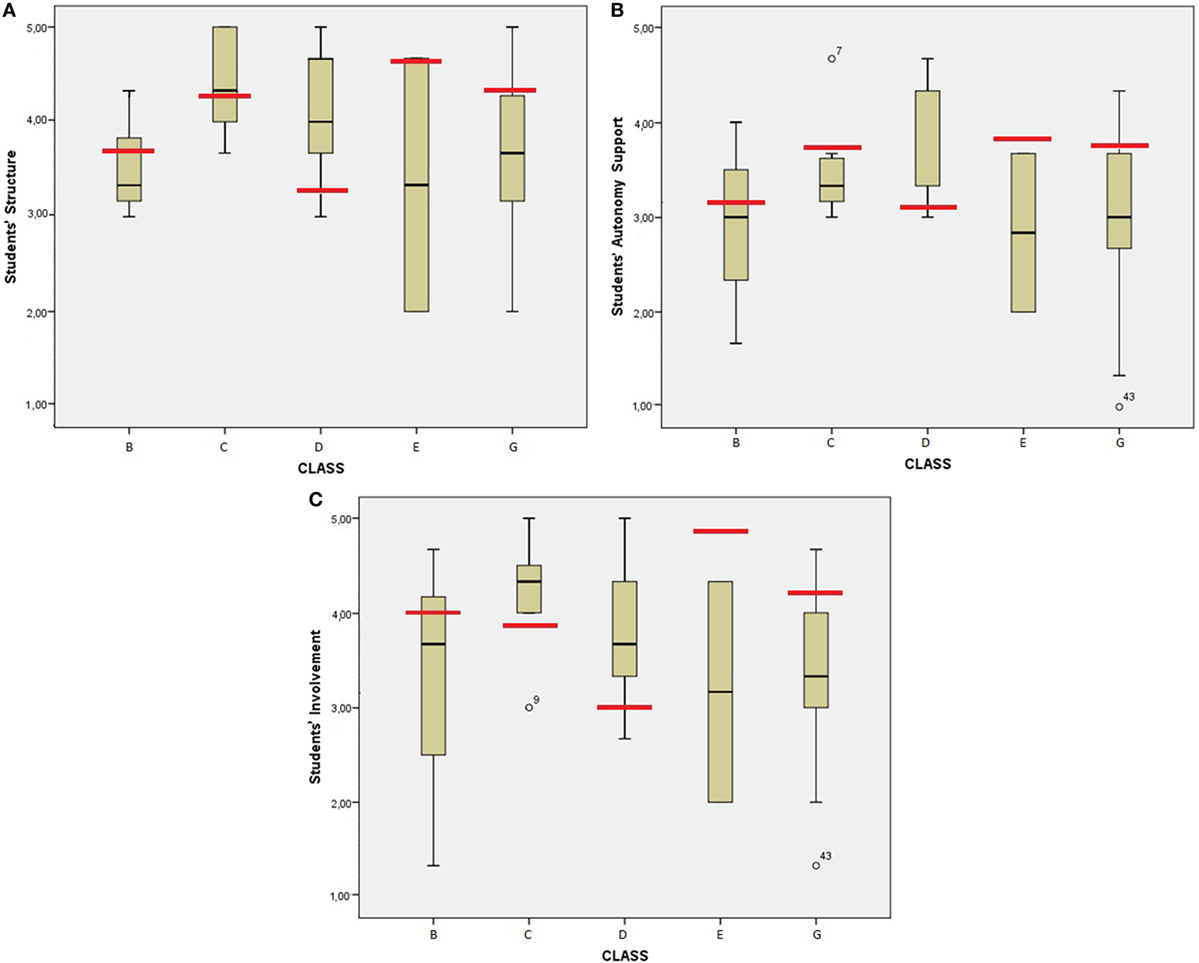
Figure 3. Teacher-provided and student-perceived (A) structure, (B) autonomy support, and (C) involvement.
The boxplots in Figure 3A show that with regard to structure, the teachers in classes B, E, and G scored higher than most students. In contrast, the students in classes C and D are more positive than the teachers. Figure 3B presents the boxplots of the scores on autonomy support. Most students in classes B, C, E, and G are less positive about their teacher’s autonomy support than their teacher. Only the students in class D are more positive than their teacher. The boxplots of the involvement scores are presented in Figure 3C. The teacher scores in classes B, E, and G are higher than the student scores. In classes C and D, this is the other way around.
Research Question 4: What Is the Relationship between Teacher-Provided and Student-Perceived Need Support and Student Engagement in Learning?
Figure 2 shows that similar to teacher-provided need support and student-perceived need support, student engagement scores also fell in the range between 3 and 5. The first impression is, therefore, that teacher-provided need support corresponds with student-perceived need support and student engagement. However, a very different picture emerges when we consider the variety in individual student scores per class. The boxplots in Figures 4 and 5 visualize the range in student engagement scores and their correspondence with the provided and perceived need support. The boxplots show the range in either student behavioral or emotional engagement. The letter T indicates teachers’ mean scores on their structure, autonomy support, and involvement. The letter S indicates how students perceived their teachers’ structure, autonomy support, and involvement.
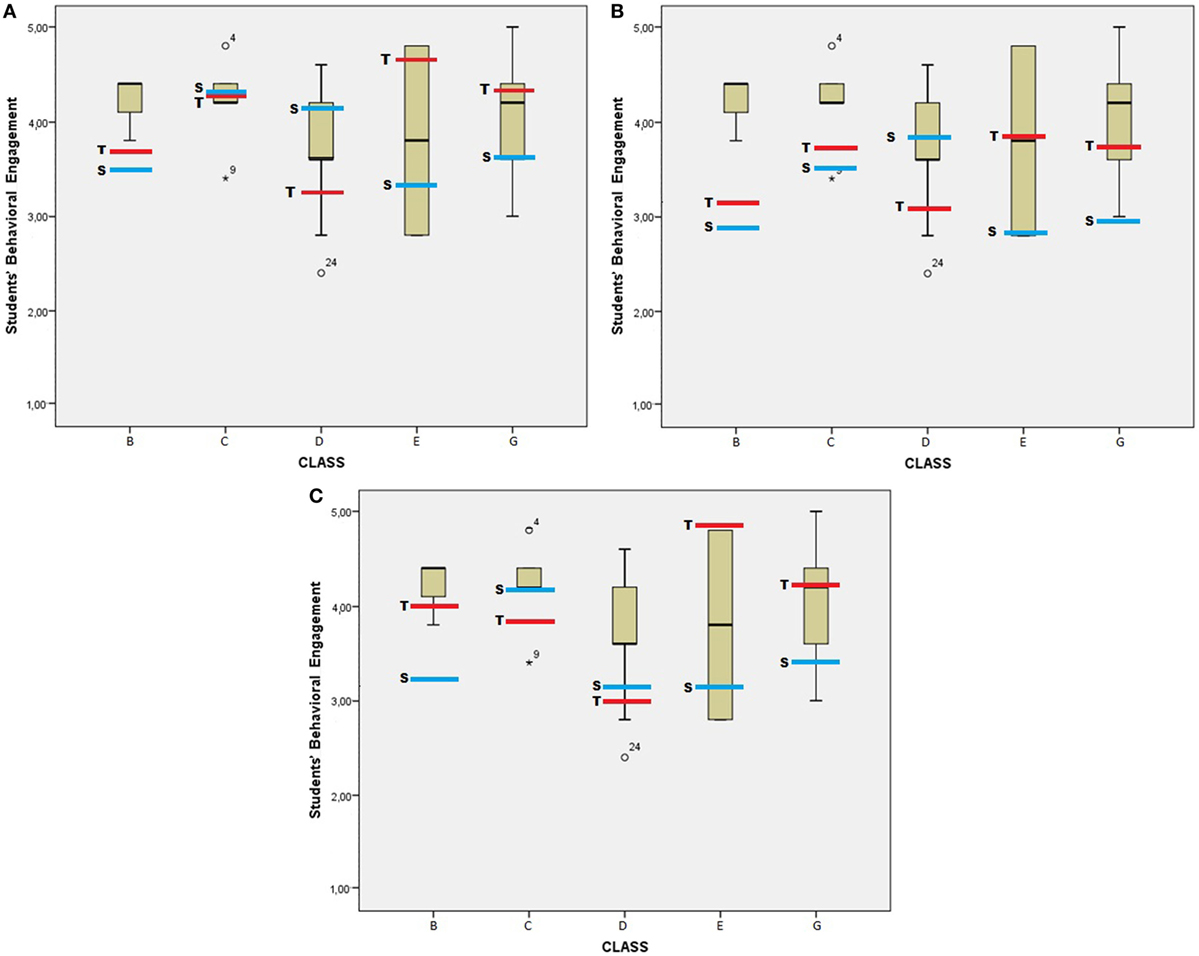
Figure 4. Students’ behavioral engagement, teacher-provided and student-perceived (A) structure, (B) autonomy support, and (C) involvement.
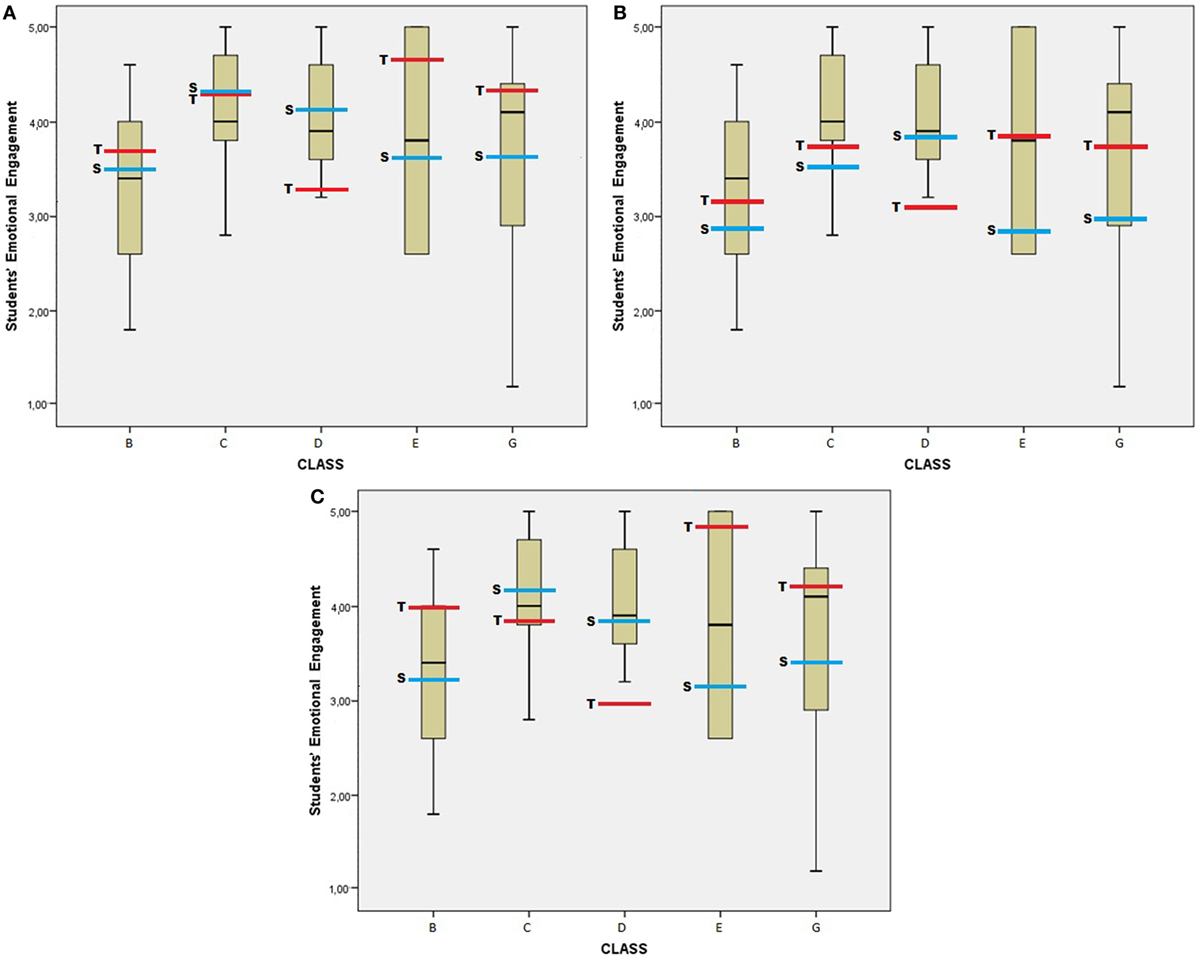
Figure 5. Students’ emotional engagement, teacher-provided and student-perceived (A) structure, (B) autonomy support, and (C) involvement.
Figure 4A shows students’ behavioral engagement scores and teacher-provided and student-perceived structure, Figure 4B shows autonomy support and Figure 4C shows involvement. Figures 5A–C present the results for students’ emotional engagement. The figures show differences per class with regard to students’ behavioral and emotional engagement. Moreover, the figures show that students’ behavioral and emotional engagement scores are not identical to their perceived need support or to their teacher-provided need support. In some cases, teacher-provided need support is higher than student engagement and in others it is lower. The same holds for student-perceived need support and their engagement scores. It is difficult to see a link between either a high or low behavioral or emotional engagement score and a specific pattern in the scores for teacher-provided need support and student-perceived need support.
Discussion
The purpose of the current study was to explore the relationship between need-supportive teaching and the motivation of students with visual impairments in secondary education language classes. The results show a positive picture with regard to teacher-provided and student-perceived need supports. Our first and second research question can both be answered positively: (a) in general teachers are positive about the amount of support they provide to their students; (b) in general students are positive about the support their teachers provide; and (c) in general students indicate they are engaged in learning activities in the classroom.
Despite these positive findings, the results of this study also suggest there is still room for improvement, since no ceiling effects occurred in the mean scores. In other words, no maximum scores occurred in either the teacher or student mean scores. Most improvement can be attained in the domain of autonomy support, since autonomy support was the lowest reported form of need support by both teachers and students. This is in line with previous research on students with deafblindness (Haakma et al., 2016b, 2017b), which also identified autonomy support as the least provided form of support by teachers of students with congenital and acquired deafblindness. Moreover, existing research on students with visual impairments has also indicated that these students often do not get much opportunity to behave in autonomous, self-determined ways. Agran et al. (2007), for instance, found that students who are blind or have low vision are given few opportunities to be self-determined and would benefit from instruction in self-determination. In addition, Robinson and Lieberman (2004) and Bardin and Lewis (2011) also reported that students with visual impairments have very few opportunities to engage in self-determined behavior.
An explanation for this finding could be that teachers underestimate students’ capacities. For instance, Powers et al. (1998) reported that many professionals believe that individuals with sensory loss have difficulty making appropriate decisions and, therefore, often make decisions for them. However, feeling autonomous is extremely important, especially for this group of students, who often heavily rely on others. Sacks et al. (2011) noted, for instance, that students with low vision need to be instructed in self-advocacy so they can make their own needs known. According to Bardin and Lewis (2008), students with visual impairments often have difficulties with skills and attitudes that have been identified as positively influencing student engagement, such as personal competence, motivation, self-determination, and peer relationships. Teachers of students who are blind or have low vision can increase academic engagement by emphasizing the self-determination of their students and making choices together with their students. In sum, this study highlights the importance of addressing autonomy support in the education of students with visual impairments, in line with previous research.
Our third research question looked at differences between teachers’ self-reported need support and the need support perceived by their students. The simplest answer to this question would be that teacher and student scores are generally very close, but teachers are somewhat more positive about their need-supportive behavior than their students. If we look at individual student scores, we also see large differences between teachers and students. It is surprising that teacher and student scores differ so much. It is remarkable that a teacher could think that he or she provides a lot of structure, autonomy support, and involvement, but that the students do not experience this in the classroom. The other way around is also quite remarkable: when students experience a lot more need support than the teacher indicates. A difference in perception could occur, for instance, if teachers believe they provide a lot of choices in their lesson, while the students feel they have no choice at all. A teacher may be providing the wrong choices, choices that are not experienced as choices or are not relevant for students. For example, a choice between two boring books for a reading assignment might not be experienced as autonomy enhancing. It becomes especially interesting when students experience something as a choice, without the teachers realizing they are offering a choice. It is intriguing to look at how such a situation might occur. These findings are certainly of interest and call for further research.
Our fourth research question looked at whether there is a relationship between teacher-provided and student-perceived need supports and student engagement in learning. In general, students were quite positive about their teachers’ need-supportive behaviors, and this resembles their engagement scores. Both their behavioral and emotional engagement scores were quite positive. The scores, therefore, seem to correspond at first sight. However, when we look more closely again, we can observe many differences between teacher-provided need support, student-perceived need support, and students’ behavioral and emotional engagement. We were not able to specify which specific teacher or student variables positively or negatively influenced students’ behavioral or emotional engagement.
Moreover, given the nature of the collected data, we cannot determine causal relationships. We cannot conclude that need-supportive teaching actually results in engaged learning behavior. Due to the small sample size, we need to interpret the data with caution. We can only use descriptive statistics, and not inferential statistics, to compare the teacher and student scores. Although a sample size of 48 students is quite large compared to other studies on students with visual impairments, the students in our study are distributed over seven classes, meaning the groups are still very small. The uneven distribution of students over classes also makes it hard to compare classes and to draw conclusions about causality.
Taken together, our findings for all four research questions showed differences between the classes with regard to both the teacher and student scores and the differences between these two. We tried to explain these findings by taking into account certain teacher and student characteristics. However, the small sample size of seven teachers makes it hard to identify explaining factors. We found no patterns in the differences between genders, years of experiences, or educational background to explain the findings. We also looked at student characteristics that might explain the differences between students. However, our analyses did not result in any clear patterns with regard to differences, such as gender, the cause of visual loss, the age of onset, or the degree of visual loss.
Our sample consisted mainly of special educational settings. Only one mainstream setting was included. We expected lower scores in this mainstream class compared to the classes in special educational settings. Teachers in mainstream schools are often not trained to meet the unique needs of visually impaired children. Moreover, class sizes are often much larger in mainstream settings. We expected a teacher would more easily be involved in a group of six students than in a group of 25 students. We also expected the scores for students’ perceived need support to be much lower in the larger mainstream classes than in the smaller special classes. Surprisingly, this was not the case at all. In contrast, the student in the mainstream class reported very positive scores. This is only one individual student and one teacher, so we cannot generalize this to other cases. It would be valuable to explore this more in depth in future research and to include more teachers and students in mainstream education settings.
One teacher with visual impairment participated in the study. We expected this teacher to have the highest scores on need-supportive teaching. Her self-reported scores were indeed at the highest level of need support. However, the mean class scores of her students were much lower than her self-reported scores. Again, the number of students was limited: only two. One gave very positive scores, in line with the teacher’s scores. In contrast, the other student gave much lower scores. This indicates that even within classes perceived need support can differ greatly.
In future research, it would be interesting to explore these differences between students. In this study, we used questionnaires. Future research could use a more open method of data collection to explore the different views of students and teachers on need-supportive teaching in the classroom. This could be done, for instance, by organizing classroom discussions with teachers and students to discuss various elements of need-supportive teaching.
This finding stresses the importance for teachers to really know each individual student in a classroom. It requires teachers to check whether each of their students’ psychological needs are supported or whether they should adjust their need-supportive teaching strategies. This is certainly not an easy task. Teachers have a lot on their plates: conveying content knowledge, managing the classroom, adjusting the classroom to the students’ visual needs, adjusting communication to students’ visual needs, and giving attention to those who have difficulty with keeping up or those who have a hard time concentrating.
We recommend that teachers wanting to investigate whether they divide their attention equitably among students ask a colleague for help. A colleague could observe a lesson and focus specifically on student engagement. This observer could later share their insights on how the teacher could keep each student engaged during class. Another method is to make video recordings of a lesson and then look back at the lesson. Video recordings can help in assessing need-supportive teaching and clearly show what effect the teacher’s behavior has on the students (Haakma et al., 2016b).
In conclusion, a large amount of research highlights the importance of supporting the basic psychological needs of students in a classroom. Previous research has shown that when students feel competent, autonomous, and involved in their classroom, this has a positive effect on their engagement to learn. It is, therefore, very important to pay attention to such motivational processes in education. This study adds to the existing knowledge base. The findings illustrate that need-supportive teaching is also important in the education of students with visual impairments. Based on the findings derived from this study, we would strongly recommend that policymakers and curriculum developers incorporate insights into motivational processes and need-supportive teaching in the education of preservice teachers. Incorporation of these insights can help ensure that future teachers know how to support the psychological needs of students with visual impairments in their everyday classroom practice.
Ethics Statement
All students completed the student questionnaire. The first section of the questionnaire contained the informed consent form. In the form, it was stated that participation in the study was voluntary along with other information. The consent form was used to obtain the written consent of the students. In addition, all teachers, students, and parents received an information letter that explained the study purpose and content. Objecting parents were able to withdraw participating students from the study. Written and informed consent was also obtained from all teachers who completed the teacher questionnaire. The Ethics Committee Pedagogical and Educational Sciences of the University of Groningen has reviewed and approved the study and concluded that the criteria of scientifically responsible behavior were met. All consent procedures were approved by the Ethics Committee Pedagogical and Educational Sciences of the University of Groningen.
Author Contributions
All authors listed have made a substantial, direct, and intellectual contribution to the work and approved it for publication.
Conflict of Interest Statement
The authors declare that the research was conducted in the absence of any commercial or financial relationships that could be construed as a potential conflict of interest.
Acknowledgments
The authors would like to thank the teachers and students for participating. They would also like to thank Jillian Hakvoort, Gelske Bosch, Wilrieke Alingh, and Eva Hamhuis for contributing to this study.
Funding
This study received funding from the University of Groningen, Department of Special Needs Education and Youth Care, The Netherlands.
References
Agran, M., Hong, S., and Blankenship, K. (2007). Promoting the self-determination of students with visual impairments: reducing the gap between knowledge and practice. J. Vis. Impair. Blind. 101, 453–464.
Appleton, J. J., Christenson, S. L., and Furlong, M. J. (2008). Student engagement with school: critical conceptual and methodological issues of the construct. Psychol. Sch. 45, 5. doi: 10.1002/pits.20303
Bardin, J. A., and Lewis, S. (2008). A survey of the academic engagement of students with visual impairments in general education classes. J. Vis. Impair. Blind. 102, 472–483.
Bardin, J. A., and Lewis, S. (2011). General education teachers’ ratings of the academic engagement level of students who read braille: a comparison with sighted peers. J. Vis. Impair. Blind. 105, 479–492.
Chang, S., and Schaller, J. (2002). The views of students with visual impairments on the support they received from teachers. J. Vis. Impair. Blind. 96, 558–575.
Deci, E. L., and Ryan, R. M. (2000). The ‘what’ and ‘why’ of goal pursuits: human needs and the self-determination of behavior. Psychol. Inq. 11, 4. doi:10.1207/s15327965pli1104_01
Fredricks, J. A., Blumenfeld, P. C., and Paris, A. H. (2004). School engagement: potential of the concept, state of the evidence. Rev. Educ. Res. 74, 1. doi:10.3102/00346543074001059
Haakma, I., Janssen, M., and Minnaert, A. (2016a). A literature review on how need-supportive behavior influences motivation in students with sensory loss. Teach Teach Educ 57, 1–13. doi:10.1016/j.tate.2016.02.008
Haakma, I., Janssen, M., and Minnaert, A. (2016b). Understanding the relationship between teacher behavior and student motivation in students with acquired deafblindness. Am. Ann. Deaf 161, 314–326. doi:10.1353/aad.2016.0024
Haakma, I., Janssen, M., and Minnaert, A. (2017a). The influence of need-supportive teacher behavior on the motivation of students with congenital deafblindness. J. Vis. Impairments Blindness 111, 247–260.
Haakma, I., Janssen, M., and Minnaert, A. (2017b). Intervening to improve teachers’ need-supportive behaviour using Self-Determination Theory: its effects on teachers and on the motivation of students with deafblindness. Int. J. Disabil. Dev. Educ. 64, 310–327. doi:10.1080/1034912X.2016.1213376
Jang, H., Reeve, J., and Deci, E. L. (2010). Engaging students in learning activities: it is not autonomy support or structure but autonomy support and structure. J. Educ. Psychol. 102, 3. doi:10.1037/a0019682
Opdenakker, M. C. J. L. (2014). Leerkracht-leerlingrelaties vanuit een motivationeel perspectief: het belang van betrokken en ondersteunende docenten. Pedagogische Studiën 91, 332–351.
Pinquart, M., and Pfeiffer, J. P. (2012). Psychological adjustment in adolescents with vision impairment. Int. J. Disabil. Dev. Educ. 59, 2. doi:10.1080/1034912X.2012.676416
Powers, L. E., Turner, A., Westwood, D. H., Loesch, C., Brown, A., and Rowland, C. (1998). “Take charge for the future: a student-directed approach to transition planning,” in Making It Happen: Student Involvement in Education Planning, Decision Making, and Instruction, eds M. Wehymeyer, and D. Sands (Baltimore, MD: Paul H. Brookes), 187–210.
Robinson, B., and Lieberman, L. (2004). Effects of visual impairment, gender, and age on self-determination. J. Vis. Impair. Blind. 98, 350–366.
Sacks, S. Z., and Silberman, R. K. (1998). Educating Students Who Have Visual Impairments with Other Disabilities. Baltimore: Paul H. Brookes Publishing Co.
Sacks, S. Z., Lueck, A. H., Corn, A. L., and Erin, J. N. (2011). Supporting the social and emotional needs of students with low vision to promote academic and social success. Position Paper of the Division on Visual Impairments, Council for Exceptional Children. Arlington, VA: Council for Exceptional Children.
Stroet, K., Opdenakker, M. C., and Minnaert, A. (2013). Effects of need supportive teaching on early adolescents’ motivation and engagement: a review of the literature. Educ. Res. Rev. 9, 65–87. doi:10.1016/j.edurev.2012.11.003
Vansteenkiste, M. (2010). Hoe we kinderen en jongeren kunnen motiveren. Toepassingen van de zelfdeterminatietheorie. Caleidoscoop. 22, 6–15.
Keywords: visual impairments, self-determination theory, need-supportive teaching, motivation, engagement, special needs education
Citation: Haakma I, Janssen MJ and Minnaert AEMG (2018) Need Support in Students with Visual Impairments: Comparing Teacher and Student Perspectives. Front. Educ. 2:71. doi: 10.3389/feduc.2017.00071
Received: 14 October 2017; Accepted: 21 December 2017;
Published: 25 January 2018
Edited by:
Graeme Douglas, University of Birmingham, United KingdomReviewed by:
Anna Logan, Dublin City University, IrelandGregor Ross Maxwell, University of Tromsø, Norway
Copyright: © 2018 Haakma, Janssen and Minnaert. This is an open-access article distributed under the terms of the Creative Commons Attribution License (CC BY). The use, distribution or reproduction in other forums is permitted, provided the original author(s) or licensor are credited and that the original publication in this journal is cited, in accordance with accepted academic practice. No use, distribution or reproduction is permitted which does not comply with these terms.
*Correspondence: Ineke Haakma, aS5oYWFrbWFAcnVnLm5s
 Ineke Haakma
Ineke Haakma Marleen J. Janssen
Marleen J. Janssen Alexander E. M. G. Minnaert
Alexander E. M. G. Minnaert
